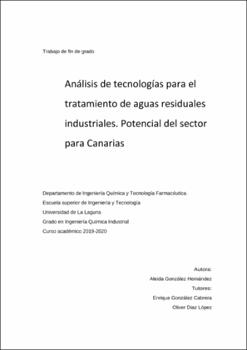Análisis de tecnologías para el tratamiento de aguas residuales industriales: potencial del sector para Canarias.
Fecha
2020Resumen
El objetivo de este trabajo de fin de grado (TFG) es analizar las tecnologías disponibles para
el tratamiento de las aguas residuales industriales originadas en la Isla de Tenerife.
En primer lugar, se ha analizado la legislación vigente aplicable a las aguas residuales
industriales. A continuación, se han revisado las tecnologías convencionales y avanzadas,
realizando un estudio del estado actual de la tecnología a partir de información comercial,
de bibliografía científica y de patentes. En el desarrollo del TFG se han analizado las
principales industrias de la isla con el fin de analizar las principales fuentes de producción
de las aguas residuales industriales. Con el fin de concretar y facilitar la búsqueda de
tratamientos de una forma más visual y específica, se ha elaborado un conjunto de tablas
que permiten identificar las mejores técnicas aplicables para los principales contaminantes.
Los resultados revelan que las industrias agroalimentarias representan el mayor número de
industrias en la provincia, por lo que se profundiza en la caracterización de las aguas de
vertido de la industria láctea, cárnica y de zumos, para posteriormente proponer sistemas
de tratamiento aplicada a cada una de ellas. The objective of this final degree project (TFG) is to analyze the technologies available for
the treatment of industrial wastewater on the Island of Tenerife.
First, the current legislation applicable to industrial wastewater has been analyzed. Next,
conventional and advanced technologies have been reviewed. A study of the current state
of technology based on commercial information, scientific bibliography and patents has been
done. In the development of the TFG, the main industries of the island have been analyzed
in order to analyze the main sources of industrial wastewater production. To specify and
facilitate the search for treatments in a more visual and specific way, a set of tables has been
prepared that allow the best applicable techniques to be identified for the main pollutants.
The results reveal that the agri-food industries represent the largest number of industries in
the province, which is why the characterization of the wastewater from the dairy, meat and
juice industries is deepened, to later propose treatment systems applied to each one of them.





